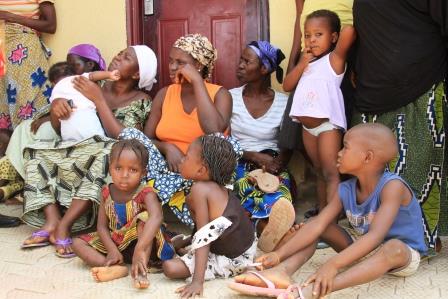The recently released Trends in maternal mortality: 1990 to 2013 Estimates by WHO, UNICEF, UNFPA, The World Bank and the United Nations Population Division has reawaken our desire in Nigeria to have a common position as to what is the Nigeria’s MMR. We are aware of the 2012 MDG Report which is yet to be presented, published, disseminated or shared to interested stakeholders that pegs Nigeria’s MMR as 350/100,000. This figure has already being quoted severally by the President of Nigeria and some few senor policy makers in some meetings even though the MDG office is still reluctant to share the report and the methodology used. In one of my published articles I termed the survey as “Clandestine and dark hours of the night survey. Iam yet to get a reply or counter argument on this assertion.
The 2013 NDHS report which its preliminary findings are already out has not pegs the Nigerian MMR. We hope the NDHS full report when out this year and shared will tell us the Nigeria’s MMR as it will give us a chance to make a comparison with the 2012 MDG report and the WHO estimates.
WHO defines maternal death as: “The death of a woman while pregnant or within 42 days of termination of pregnancy, irrespective of the duration and site of the pregnancy, from any cause related to or aggravated by the pregnancy or its management but not from accidental or incidental causes.”
Method and Result:
These latest estimates use an improved methodology and data gathered from country consultations, compared to previous estimates. The methodology for estimating births and all female deaths, and the steps necessary for estimating the maternal mortality ratio, have improved. Furthermore, new data not captured in the 2012 estimates was included in the 2013 round. Measuring the MDG 5 target of reducing the maternal mortality ratio (MMR) (target 5A) remains a challenge. Less than 40% of countries have a complete civil registration system with good attribution of cause of death, which is necessary for the accurate measurement of maternal mortality. The estimates for 2013 presented in this report are the seventh in a series of analyses by the United Nations agencies. The Maternal Mortality Estimation Inter-Agency Group (MMEIG) have been working together to generate internationally comparable MMR estimates. A technical advisory group (TAG) provides independent technical advice. The methods, as well as the data sources for the estimation of MMR, have improved over time. Building on the methodological advancements from the previous round of analyses, newly available data collected by MMEIG and obtained during country consultation were incorporated, and trend estimates from 1990 to 2013 were generated. As with the previous round of estimates, the statistical code and input data necessary to produce the current estimates are made publicly available, underscoring the MMEIG’s commitment to open access and transparency. Globally, there were an estimated 289 000 maternal deaths in 2013, a decline of 45% from 1990. The sub-Saharan Africa region alone accounted for 62% (179 000) of global deaths followed by Southern Asia at 24% (69 000). At the country level, the two countries that accounted for one third of all global maternal deaths are India at 17% (50 000) and Nigeria at 14% (40 000). The global MMR in 2013 was 210 maternal deaths per 100 000 live births, down from 380 maternal deaths per 100 000 live births in 1990. The MMR in developing regions (230) was 14 times higher than in developed regions (16). Sub-Saharan Africa has the highest regional MMR (510).
Other Key Findings are;
- Global maternal mortality has reduced by 45% between 1990 and 2013.
- In 2013, an estimated 289,000 women died due to complications in pregnancy and childbirth, down from 523,000 in 1990.
- Sub-Saharan Africa is the region with the highest MMR (510 maternal deaths per 100,000 live births), accounting for 62% (179,000) of global maternal deaths.
- The MMR in developing regions (230 maternal deaths per 100,000 live births) was 14 times higher than in developed regions (16 maternal deaths per 100,000 live births).
- The report places 12 countries as ‘on track’ to meeting MDG5: Maldives, Bhutan, Cambodia, Equatorial Guinea, Lao People’s Democratic Republic, Romania, Timor-Leste, Cabo Verde, Eritrea, Nepal and Rwanda.
The Nigeria’s profile of maternal mortality trends is published by the United Nations agencies based on their latest estimates for 1990-2013. It was published with the new report Trends in Maternal Mortality: 1990-2013. The full report presents internationally comparable maternal mortality ratio (MMR) estimates, including trends from 1990 to 2013.
Nigeria;
- Nigeria is estimated to have an MMR of 560 maternal deaths per 100,000 live births.
- MMR in Nigeria has declined by 52% between 1990 and 2013.
- The average annual % change in MMR between 1990 and 2013 was -3.1%.
- The estimated number of maternal deaths for 2013 is 40,000.
- The lifetime risk of maternal death is 1 in 41.
- Nigeria is classified as ‘making progress’ towards maternal health, rather than ‘on track’ or ‘insufficient progress’.
The report finally observed that when considering progress made towards achievement of MDGs, some common elements of success have emerged, including: leadership and partnership, evidence and innovation, development and implementation of dual short-term and long-term strategies, and adaptation to change for sustained progress. When reviewing the 2013 MMR in Nigeria these elements above should come into full view vis-à-vis the role they played in reducing our MMR.
This article was 1st published in Daily Trust Newspaper of 13th May 2014 by Dr Aminu Magashi




